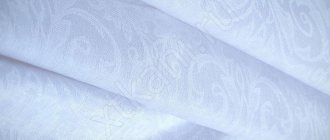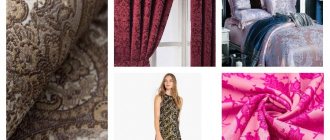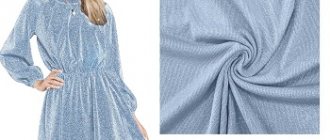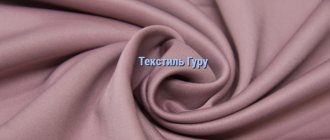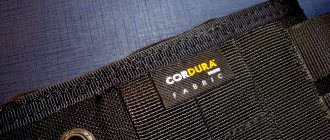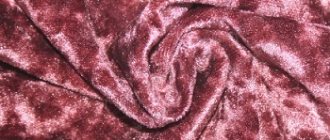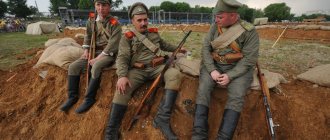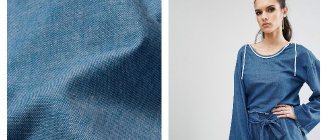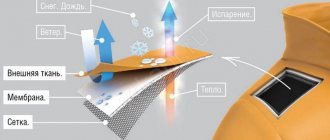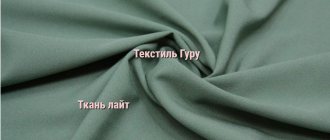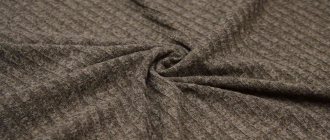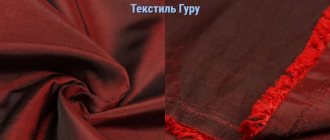| What is it called differently: | viscose, rayon, rayon |
| Natural or synthetic? | artificial |
| How does it feel? | soft, durable, elastic |
| Application: | clothing (dresses, blouses, summer trousers), light blankets, bedspreads, curtains, children's clothes, toys, towels, pillowcases, stockings, socks, underwear, bed linen, outerwear |
| Fabric structure: | simple (smooth or main) weave, satin (satin) spinning |
| Does it stretch or not? (Extensibility) | stretchable fabric |
| Recommended washing temperature: | +30—40 ⁰С |
| Washing mode: | delicate |
| Press: | for 10 minutes at minimum speed |
| Kinds: | modal, bamboo, flowing rayon, lyocell |
| Presence of shine: | shiny material |
| Degree of creasing: | wrinkles a lot |
| Edge fraying: | crumbles a lot |
| Hygroscopicity: | above average |
| Drapability: | excellent |
| Ability to keep warm: | good or low depending on variety |
| Shrinkage: | deforms if not cared for properly |
| Breathability: | sufficient |
| Fade or not: | color fast fabric |
When choosing a blouse in an online store and carefully studying the characteristics of the fabric, not every fashionista will decipher the designation “100% rayon” in the composition column. What kind of material is this, natural or artificial? In fact, everything is simple, and the more common name for rayon fabric is viscose, or “artificial silk.”
Description
Rayon is an artificial fabric made from natural wood raw materials or cellulose. Twill, crepe, knitted, satin and silk weaving are used to join threads into fabric. Modern technologies make it possible to give the material the texture of linen or wool, as well as change the density.
The fabric is pleasant to the touch and can be draped. When incorporated into acetate or polyester, a distinct satin sheen appears. The most attractive fabrics are made from viscose with natural silk. They have a matte or velvety surface with satin fragments or a relief pattern. A variety of shades, patterns and textures can be seen in the photo.
The name rayon comes from the word ray (ray) or bright, colorful. The ending on indicates cotton and the natural origin of the fabric. Read as "district" or "rayon".
conclusions
- The basis of the material is wood cellulose that has undergone chemical treatment. The composition may also contain lycra and polyester.
- The rayon is elastic, breathable and hygienic. It is color fast and resembles silk in appearance.
- The types of fabric depend on the type of threads used in them.
- The material is used to make clothing, household items and faux fur. And faux fur is subsequently used when sewing outerwear and bedspreads.
History of appearance
The beginning of the material begins in the middle of the 19th century. At this time, in England, J. Mercer first described the process of regenerating an aqueous solution of cellulose, which was used industrially in 1957. In 1892, they learned how to convert the solution into viscose fiber, which became the raw material for rayon. Mass distribution of the material began in 1924 from the USA, where it was called artificial silk.
Comparison of viscose and natural silk
- The natural moisture content of the fiber for making rayon fabric is about 11%. This figure is approximately the same as for natural silk fabrics.
- The specific gravity of artificial silk exceeds that of natural silk by 10%.
- The material rayon is inferior in strength to natural silk fabrics by two to four times. In a wet state, the strength indicator of the area drops significantly, losing from the initial values to 68%. After drying, this parameter is restored to its original values.
- In terms of elasticity, rayon fabric is 1.5-2 times inferior to natural silk.
- The transverse shape of viscose silk fibers has a less regular cut than that of natural fibers.
Production
The production process consists of two stages. First, wood pulp is obtained. To do this, the crushed material is boiled for 24 hours in calcium hydrosulfite. Then the mass is diluted with water, dried on a conveyor belt and cut into layers. After several cycles of chemical treatment, the composition becomes suitable for creating a spinning solution.
In the second stage, cellulose anthogenate is transformed into viscose yarn. The technology involves treatment with caustic soda, then with carbon disulfide to create a viscous spinning solution. It is forced under pressure through a steel plate with holes called a die. Thin streams of substance come out of it and fall into the acid, turning into viscose fiber, which serves as the basis for manufacturing.
How is rayon fabric made?
To produce fabric, the region uses available raw materials in the form of wood waste. As a result of well-developed technology, additional methods of twisting threads and processing fibers, it is possible to obtain material with good consumer qualities.
If we look at the technological process schematically, we can distinguish two main stages:
- The wood is processed into cellulose and liquid viscose is obtained from it.
The prepared raw materials are heated in a soda solution for several hours. Then the resulting mass is dried, crushed again and left to “ripen” for several days at a certain level of humidity and temperature in metal containers. The alkali cellulose is again ground together with carbon disulfide. They immerse it again in a caustic soda solution and obtain cellulose xanthate, from which liquid viscose is actually obtained.
- Production of viscose threads
The resulting spinning solution is passed through a metal plate with holes (a spinneret) into a container with a solution of sulfuric acid and the threads are drawn out. When exposed to acid, cellulose xanthate hardens and turns into cellulose fibers.
This stage is similar to the air-hardening of silk threads released by a silkworm under the natural conditions of silk formation.
Viscose threads are spun from the resulting fibers. And the material rayon is made from them. Depending on the shape of the spinning machine, the fibers can be flat, round, or arc-shaped.
To obtain viscose silk, you need threads with certain parameters. They should be light. If we use the international unit of measurement for thread thickness - denier (equal to the ratio of mass to 9000 meters of thread-like fiber), then viscose silk threads are characterized by indicators from 100 to 300 denier. 1 km of thread at a value of 100 denier weighs only 11.1 g.
In Russia, to measure the linear density of a thread (fiber), the unit of measurement is tex (T), the length of which is 1 km and the mass is 1 g.
The processing features of cellulose pulp make it possible to dye viscose fibers already at the final stage of production. The desired dye is added to the reaction mixture and high-quality colored products are obtained, which are distinguished by the brightness of the colors and a variety of colors.
Compound
Rayon consists of natural raw materials that have undergone several levels of chemical processing. Combination with other fibers allows you to impart the desired properties.
The fabric composition of the rayon is presented in several versions:
| Viscose | Polyester |
| 20% | 80% |
| 100% | |
| 80% | 20% |
| 60% | 40% |
Expert opinion
Alyona
Fabric expert and technologist Alena Khlebnikova is ready to answer your questions.
Write to us
An experiment will help you make sure that your choice is correct. It is enough to set fire to a piece of fabric. Rayon smells like burning paper and emits white smoke. If synthetic additives are present, a chemical odor and black smoke will appear.
How to spot fakes
Sometimes synthetic fabrics are offered under the guise of a region. How can you identify a counterfeit yourself?
- Rub the material on a glass rod. Viscose silk will not be electrified, synthetic silk is easily electrified.
- Try to smell the fabric. Viscose materials can only smell natural; synthetics can smell slightly unpleasant.
- The rayon absorbs water very well, better than cotton and synthetic fabric.
- Viscose silk is highly breathable. Place the cloth on your hand and blow on it. If the skin feels a breeze, it means you have viscose.
- A very reliable method of identifying counterfeits is burning. It is not easy to obtain multiple fibers of the material. If you manage to separate them at the seams on the reverse side, set them on fire and observe. Synthetics melt and release an unpleasant odor. The area is smoldering, emitting white smoke and the smell of burning paper.
Beautiful, inexpensive rayon fabric has found wide application in sewing clothes, home textiles, linen, scarves, and shawls. Durable coloring, long service life with proper care allows you to use the material for a long time.
Properties and characteristics
The fabric has a long history of production and has not lost its popularity, which is explained by its properties as high-quality fabrics. Rayon is superior to viscose in strength and elasticity. The strength of the fiber is 2-4 times lower than that of natural silk. Hygienic characteristics are equal to cotton and linen. The elasticity index is considered average, lower than silk and wool, but higher than that of cotton fabrics. Rayon is able to absorb moisture even better than cotton and linen.
Rayon has a number of undeniable advantages:
- Comfortable to wear.
- Elasticity to withstand fiber tension.
- Air permeability and thermal conductivity, which is important for summer clothing.
- Good ventilation for comfort.
- The smooth surface and special structure resist dirt.
- The canvas is easy to paint and has a shiny sheen.
- Hygienic and hypoallergenic, comparable to cotton and linen.
- Does not fade or fade during use.
Among the disadvantages, users note that natural viscose material wrinkles a lot. The presence of synthetics in the composition eliminates this problem. Products made from rayon can shrink and become deformed if not properly maintained. When cutting, the material slides and shifts, which causes difficulties and inconvenience.
Important! The fabric crumbles and frays along the cuts. This feature must be taken into account when cutting and processing seams.
What kind of “thing” are you?
You don't often hear the word rayon in conversation. For many, textiles under this name do not evoke any associations, and some are hearing it for the first time. What kind of fabric is rayon? The name is interesting, but few people are familiar with it. There is an assumption that this is a completely new type of textile fabric, which has not yet found its fans and has not shown its best qualities. Not at all. This opinion is wrong.
Rayon fabric is a viscose fabric, the light industry has extensive experience in using it. Viscose is a natural product, it is natural cellulose. But why then is the fiber labeled as artificial? It's simple.
How do you get it?
Natural cellulose is used to make fiber, but during the production process it is chemically treated. The process of converting cellulose into viscose is a rather labor-intensive process that requires special conditions and equipment. Rayon fabric is a type of textile fabric consisting of viscose fibers. It turns out interesting: the material used for production is natural, and the resulting fiber is artificial.
Where are you from?
The appearance of fiber in the region was first predicted by Hooke in the 17th century. This is an English naturalist who studied the natural process of converting mulberry cellulose with the help of a silkworm into two mulberries. Through his research, Hooke made a discovery that was later patented as an artificial fabric technology called rayon. Today, natural technology has been exactly transferred into a modern way.
What does it mean?
Read about: the many faces of polyester: features and characteristics
But most scientists believe that 1924 should be considered the birth of the fabric. It was at this time that the term appeared in the circles of residents of the United States of America. They called the fiber rayon.
Rayon fabric is sometimes called viscose and rayon. The literal translation into Russian of the name rayon is ray. The ray part of the word is a ray, and on is the ending, such as cotton. The word form “hints” at the similarity of viscose with cotton.
Ray means something bright (meaning a wide range of bright fabric colors). Having no points of contact with cotton and silk, rayon is a unique fabric that combines the properties of both.
Interesting fact!
Manufacturers offer two types of fabric:
- rayon - made from simply viscose fiber;
- spun rayon fabric - spun viscose.
Where is it used?
The fabric is universal. It is where lightness and an elegant look are valued. Rayon is used in the manufacture of flowing dresses and sundresses, blouses, summer skirts and trousers. The material makes delightful pareos, scarves, stoles, scarves and shawls. Rayon with silk fiber is an excellent choice for a luxurious, festive outfit.
It adequately competes with natural fabrics in terms of hygiene. Therefore, it is used for household items and as lining material. The area is suitable for casual wear and elegant, formal wear. Looks great in any incarnation.
Rayon has found application in sewing curtains, bedspreads and curtains, and interior decor. The fabric is also used to make bed linen that is comfortable and pleasant to the skin.
Rayon is valued by fashion designers and designers for its unique properties and structure. The material allows you to sew products of any complexity and style. Folds and draperies lie softly and elegantly, cutouts look delicate and natural, and darts look harmonious.
Favorite of fashion designers and designers
The material is multifaceted. It looks great in different designs. They sew from it:
- Blouses;
- Dresses;
- Trousers;
- Scarves;
- Shawls;
- Shawls;
- Curtains;
- Sheets;
- Pillowcases.
She is loved by fashion designers and respected for her “flexibility” by designers. Due to the structure of the material, it can be used to make things of varying technical complexity. All the folds on the fabric look interesting, the darts are very delicate and beautiful, the cuts and cuts look natural and easy. A model of any volume and level of complexity, the most complex style can be sewn from rayon.
Therefore, you should not be surprised when the material is used both for clothing intended for daily wear and for elegant items during special occasions. Rayon threads look very interesting on a warm blanket and on a translucent shawl. The only criterion is the diameter of the threads used.
For tailoring, Rayon is often combined with:
- polyester;
- Lycra.
Care
Important! The material is made on the basis of viscose, so when wet it becomes sensitive to mechanical stress. Properties are completely restored after drying.
Products from the area should be washed carefully.
- The fabric is afraid of high temperatures, so water is used no higher than 30°.
- Type of washing - manual or “delicate” without spinning in a machine.
- You cannot squeeze or twist the rayon.
The fabric is prone to snags. Therefore, it is necessary to avoid contact with burrs and sharp objects.
- To remove moisture, wrap the item in a terry towel and leave for 10 minutes. You can immediately hang it up to let the water drain.
- Dry in a ventilated area without additional heating.
- Iron on the “silk” setting from the reverse side.
Areas of use
Rayon produces not only elegant and colorful head scarves and neck scarves, stoles, home textiles, bedspreads, curtains, and sleeping sets. It is widely used in the manufacture of napkins, tires for racing cars, tarpaulin boots, and carpets. In light industry for the production of polyethylene, slightly changing the technical conditions. Silk yarn is sold both in bobbins for the industrial production of knitwear and for hand knitting.
You might be interested in Description of the properties of taffeta: use of fabric
Where is Rayon fabric used?
Definition of the word “District” according to TSB:
District (French rayon, literally - ray, radius) 1) a territory that stands out according to some characteristics or features. in some cases one of the taxonomic units (for example, Physiographic Region). Sometimes used as a synonym for Region. 2) In the USSR, the main unit of administrative-territorial division in rural areas, forming part of the territory of a union (autonomous) republic, territory, region, autonomous region, national district. The establishment of regional divisions falls within the competence of the highest authorities of the union republics. In most union and all autonomous republics, a list of republics is given in the constitutions. Rural republics include the territories of village councils, workers', resort, and summer cottage settlements, and cities of regional subordination. 3) In the USSR, an administrative-territorial unit created in cities with a population of over 100 thousand people. The representative body of state power in Russia is the regional Council of Workers' Deputies. 4) In some foreign countries, an administrative-territorial unit of a different order (for example, the Paris region).
Advantages and disadvantages of the material
The advantages of the fabric include environmental friendliness, hypoallergenicity, and hygiene. Children, allergy sufferers, and pregnant women can use clothing and bedding from the area. The material is not eaten by pests and does not accumulate static electricity. In addition, rayon is highly breathable, which allows you to wear clothes made from this fabric in the summer. The material is elastic, soft, and has many color options. Some varieties resemble silk in their characteristics, and their price is several times lower than natural material.
However, it cannot be said that the region does not have shortcomings.
When sewing, the fabric may fray at the edges, so you should handle it carefully. 100% viscose fabric may shrink in size after washing. When wet, rayon is easily deformed and subject to mechanical damage.
Types of viscose fabric
- Textile thread. This fabric is unusually thin and smooth, but it tears easily and makes washing difficult. Clothes are most often made from it.
- Cord thread. Textiles made from it are more durable, relatively compact and stretch well. The fabric is called cord.
- Staple thread. This is the densest viscose material of all listed; it is used in sewing warm clothes and carpets. Staple thread is also used in the manufacture of faux fur.
